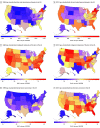The Burden of Skin and Subcutaneous Diseases in the United States From 1990 to 2017
- PMID: 32520352
- PMCID: PMC7287935
- DOI: 10.1001/jamadermatol.2020.1573
The Burden of Skin and Subcutaneous Diseases in the United States From 1990 to 2017
Abstract
Importance: Skin and subcutaneous diseases affect the health of millions of individuals in the US. Data are needed that highlight the geographic trends and variations of skin disease burden across the country to guide health care decision-making.
Objective: To characterize trends and variations in the burden of skin and subcutaneous tissue diseases across the US from 1990 to 2017.
Design, setting, and participants: For this cohort study, data were obtained from the Global Burden of Disease (GBD), a study with an online database that incorporates current and previous epidemiological studies of disease burden, and from GBD 2017, which includes more than 90 000 data sources such as systematic reviews, surveys, population-based disease registries, hospital inpatient and outpatient data, cohort studies, and autopsy data. The GBD separated skin conditions into 15 subcategories according to incidence, prevalence, adequacy of data, and standardized disease definitions. GBD 2017 also estimated the burden from melanoma of the skin and keratinocyte carcinoma. Data analysis for the present study was conducted from September 9, 2019, to March 31, 2020.
Main outcomes and measures: Primary study outcomes included age-standardized disability-adjusted life-years (DALYs), incidence, and prevalence. The data were stratified by US states with the highest and lowest age-standardized DALY rate per 100 000 people, incidence, and prevalence of each skin condition. The percentage change in DALY rates in each state was calculated from 1990 to 2017.
Results: Overall, age-standardized DALY rates for skin and subcutaneous diseases increased from 1990 (821.6; 95% uncertainty interval [UI], 570.3-1124.9) to 2017 (884.2; 95% UI, 614.0-1207.9) in all 50 states and the District of Columbia. The degree of increase varied according to geographic location, with the largest percentage change of 0.12% (95% UI, 0.09%-0.15%) in New York and the smallest percentage change of 0.04% (95% UI, 0.02%-0.07%) in Colorado, 0.04% (95% UI, 0.01%-0.06%) in Nevada, 0.04% (95% UI, 0.02%-0.07%) in New Mexico, and 0.04% (95% UI, 0.02%-0.07%) in Utah. The age-standardized DALY rate, incidence, and prevalence of specific skin conditions differed among the states. New York had the highest age-standardized DALY rate for skin and subcutaneous disease in 2017 (1097.0 [95% UI, 764.9-1496.1]), whereas Wyoming had the lowest age-standardized DALY rate (672.9 [95% UI, 465.6-922.3]). In all 50 states and the District of Columbia, women had higher age-standardized DALY rates for overall skin and subcutaneous diseases than men (women: 971.20 [95% UI, 676.76-1334.59] vs men: 799.23 [95% UI, 559.62-1091.50]). However, men had higher DALY rates than women for malignant melanoma (men: 80.82 [95% UI, 51.68-123.18] vs women: 42.74 [95% UI, 34.05-70.66]) and keratinocyte carcinomas (men: 37.56 [95% UI, 29.35-49.52] vs women: 14.42 [95% UI, 10.01-20.66]).
Conclusions and relevance: Data from the GBD suggest that the burden of skin and subcutaneous disease was large and that DALY rate trends varied across the US; the age-standardized DALY rate for keratinocyte carcinoma appeared greater in men. These findings can be used by states to target interventions and meet the needs of their population.
Conflict of interest statement
Figures

References
-
- Mokdad AH. The global burden of disease: a critical resource for informed policy making in the Gulf region. J Health Spec. 2016;4:162-172. http://www.thejhs.org/text.asp?2016/4/3/162/186482 doi:10.4103/2468-6360.186482 - DOI
-
- James SL, Abate D, Abate KH, et al. ; GBD 2017 Disease and Injury Incidence and Prevalence Collaborators . Global, regional, and national incidence, prevalence, and years lived with disability for 354 diseases and injuries for 195 countries and territories, 1990-2017: a systematic analysis for the Global Burden of Disease Study 2017. Lancet. 2018;392(10159):1789-1858. doi:10.1016/S0140-6736(18)32279-7 - DOI - PMC - PubMed
MeSH terms
LinkOut - more resources
Full Text Sources
Medical

